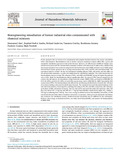JavaScript is disabled for your browser. Some features of this site may not work without it.
| dc.contributor.author | Atai, Emmanuel | |
| dc.contributor.author | Jumbo, Raphael Butler | |
| dc.contributor.author | Andrews, Richard | |
| dc.contributor.author | Cowley, Tamazon | |
| dc.contributor.author | Azuazu, Ikeabiama | |
| dc.contributor.author | Coulon, Frederic | |
| dc.contributor.author | Pawlett, Mark | |
| dc.date.accessioned | 2023-06-19T11:23:48Z | |
| dc.date.available | 2023-06-19T11:23:48Z | |
| dc.date.issued | 2023-05-18 | |
| dc.identifier.citation | Atai E, Jumbo RB, Andrews R, et al., (2023) Bioengineering remediation of former industrial sites contaminated with chemical mixtures, Journal of Hazardous Materials Advances, Volume 10, May 2023, Article Number 100319 | en_UK |
| dc.identifier.issn | 2772-4166 | |
| dc.identifier.uri | https://doi.org/10.1016/j.hazadv.2023.100319 | |
| dc.identifier.uri | https://dspace.lib.cranfield.ac.uk/handle/1826/19815 | |
| dc.description.abstract | Former gasworks sites are known to be contaminated with complex chemical mixtures that require remediation before redevelopment. Bioamendments such as biochar and spent mushroom compost (SMC) offer a green and sustainable remediation approach to help tackle this issue. However, the effectiveness of different biochar types and their interactions with the soil microbial community is still not well understood. To address this, a full factorial microcosm experiment was carried out using biochar derived from rice husk (RHB) and wheat straw (WSB) mixed with soil from a former gasworks site at varying concentrations (0%, 2.5%, and 5%), with and without SMC. The experiment aimed to evaluate the fate of contaminants including alkanes, PAHs, and metals, and their effect on the soil microbial community, as well as the implications for remediation endpoints. The results showed that the bioamendments had an average TPH reduction of 92%, with SMC and WSB-SMC having the highest degradation rates at 93%. While the bioamendments did not significantly affect the extent of TPH removal compared to the control, they did improve the degradation of high molecular weight (HMW) PAHs, particularly in RHB-SMC for EC17-20 (60%) and EC21-35 (62%) of total PAH concentration, and in WSB-SMC for HMW bioavailable PAH concentration (89%). The bioamendments also affected the partitioning and distribution of metals after 120 days of treatment, leading to decreased available phase fractions. The treatments increased microbial abundance in the soil, with Gram positives, Gram negatives, and fungi increasing by 4%, 8%, and 38%, respectively, after 120 days, particularly in SMC and mixed treatments. This was mirrored in increased microbial soil respiration. After 120 days, low metal (178 ± 5 mg/kg) and TPH (21 ± 7 mg/kg) bioavailability translated into higher EC50 (10624 ± 710 mg/L), indicating lower toxicity. There was a strong correlation between bioavailability and toxicity of TPH and metals with microbial relative abundance and activity. In summary, while green and sustainable remediation may accelerate the remediation process, monitored natural attenuation may be sufficient for site reclamation. However, this strategy, as demonstrated here, can reduce metal bioavailability, and promote the biodegradation of HMW PAHs. | en_UK |
| dc.language.iso | en | en_UK |
| dc.publisher | Elsevier | en_UK |
| dc.rights | Attribution 4.0 International | * |
| dc.rights.uri | http://creativecommons.org/licenses/by/4.0/ | * |
| dc.subject | Biochar | en_UK |
| dc.subject | Spent mushroom compost | en_UK |
| dc.subject | Legacy site | en_UK |
| dc.subject | Bioamendment | en_UK |
| dc.subject | Bioavailability | en_UK |
| dc.subject | Toxicity | en_UK |
| dc.subject | Hydrocarbon | en_UK |
| dc.subject | Metals | en_UK |
| dc.subject | Microbial community | en_UK |
| dc.title | Bioengineering remediation of former industrial sites contaminated with chemical mixtures | en_UK |
| dc.type | Article | en_UK |
Files in this item
The following license files are associated with this item:
This item appears in the following Collection(s)
-
Staff publications (SWEE) [2834]

